Japan – “Quiet Life” 1979 – 2021
It’s been a dizzying couple of weeks in the Japan fan universe. First Richard Barbieri released the incredible “Under A Spell”, which charted in the UK far better than its predecessor “Planets + Persona”. I can’t recommend the album highly enough, and plan to publish an in-depth review once quiet life has resumed. Richard’s recent conversation with Markus Reuter over on YouTube is a great watch. Then last week came “Quiet Life”, which re-entered the UK Album chart at No.13, beating it’s previous highest position in 1982 by 40 places. It is currently No.2 in the Vinyl chart.
A reissue of “Quiet Life” by Japan has been on the cards for over 2 years; indeed it was originally scheduled to be out on the 40th anniversary of its UK release (Jan 2020), but various factors prevented this. That it was going to happen seemed inevitable, due to the last (limited) vinyl release being in demand, and following on from the Virgin era Japan vinyl reissues by Universal. Prior to that the last major release of the album was in 2004, a project I worked on. In 2004 the remit was to come up with a CD package that could be produced to a budget, and that would appeal to existing fans. I was happy with the results – the album was well-mastered by Tony Cousins, and adding in a few bonus tracks and a music video, plus some nice visual elements in the packaging added value. The title was the first in its series to sell out, so was repressed and in print until 2020.
In 2021 we have another beast entirely – the LP on vinyl at an affordable price, a red vinyl limited pressing, plus a box set including the black vinyl, the CD version of the album, and two bonus discs. The set is enhanced with a 24 page large format booklet (the same size as the Japan tour programmes in the UK, but with all-new content) and an LP size gatefold to house the CDs. I was not involved closely with this edition of the release, but was in the loop throughout its development. I played no part in decisions made, but did have the opportunity to input ideas, was able to hear the new master on vinyl and contributed to social media marketing. I was given access to digital files in advance, but bought my own copies of the finished product. I am not being paid to write this blog post. So, this review can be objective, unlike for example if I were to review the 2004 release.
The LP and CD (plus the “Quieter Life” CD in the box) were remastered by Phil Kinrade at Alchemy, and in my view he’s done just as good a job as Tony Cousins did for CD in 2004 (Tony Cousins digital master was used for the Music On Vinyl release as well). Comparing the vinyl to prior pressings, it is less “hot” and needs to be cranked up but when you do, wow, very happy indeed. “Despair”, “In-Vogue” and “The Other Side Of Life” sound the best on vinyl, with great depth and less sibilance than for example the 1980 UK Hansa pressing. Aside from the volume being lower the mastering is closest to the smooth Japanese Victor original, which benefits from a low noise floor (JVC super vinyl most likely responsible). Some buyers of the red vinyl reported a manufacturing fault causing a click at the end of “In-Vogue” but my copy is not affected, and I know that the fans commenting on this in the Nightporter Facebook Group got replacements swiftly.
I used to think that the Hansa UK 1980 pressing was my favourite, and I still think it’s good, but listening in detail this week, and comparing to the Japanese Victor 1979 and new LP, it has more sibilance than both. This might be due to decades of being played! The track I like most on the Hansa is the title track “Quiet Life” – it leaps out much more on the UK LP, has more energy and excitement. The 2021 is perhaps too smooth on that track; the difference I noticed most is that the drums are more subdued than on the 79/80 pressings, which is unfortunate when a signature part of the song is the building drums during the intro and that “slam” as the song kicks off. Where the track “Quiet Life” really shines is on the 12″ single from 1981, or the Old Gold reissue from the late 80s. Overall then, I like the new LP pressing a lot, and the three tracks mentioned earlier have rarely sounded better.
Something debated in the last couple of weeks about is the claim on the hype sticker of the vinyl and box that the LP is “Half Speed Mastered”. Many people on forums have equated this with the Abbey Road series of LPs, or that it might be presented as two 45rpm discs. Neither is correct in this case, and it is a shame that the packaging couldn’t have clarified things for the audience that likes to have these details. The LP version was half speed mastered at Alchemy, based at AIR Studios, not at Abbey Road, hence no Abbey Road branding or certificate. To quote the Alchemy site: “Vinyl mastering but with the turntable, electronics and audio set to half its original speed. Your tracks will benefit from improved groove ‘accuracy’ as the cutting takes twice as long to transcribe the audio. This reduces mechanical stress and results in a smoother, more natural top end.” It does not mean that the LP will be presented as two 45rpm discs – the releases on Universal (“Gentlemen Take Polaroids” and “Tin Drum”) were also half speed mastered but made available on 45rpm (effectively the albums on two 12″ singles, allowing for a hotter cut) and 33rpm. “Quiet Life” is just available as single 33rpm disc. One day it might be nice to get it as two 45rpm discs, where the title track will really shine as it does on 12″ single. Of course any new pressing in the near future may be criticised but I wouldn’t mind at all.
I like the new CD master a lot, and see it as one of the best you can get in the format. It is a tad more compressed than the 2004, or another favourite, a 1995 Japanese BMG pressing. Both of those have a lot of depth without compromising on dynamic range. One nerdy thing that the new CD master gets perfect is the transition from “All Tomorrow’s Parties” to “Alien”. On the original vinyl and cassette the sequencer of “All Tomorrow’s Parties” does not completely fade out, with no silence before “Alien”. This was replicated in the early live 1980 shows, with “Alien” actually having the sequencer at the start of the song. I have no hesitation therefore in recommending the new CD version, which comes packaged like a replica of the vinyl gatefold if purchased separate to the box set.
The second disc in the box set “A Quieter Life” compiles most of the single mixes, extended versions and b-sides related to the album, as well as the “Live In Japan” EP, previously available as a bonus with the 2004 “Obscure Alternatives”. Back then, it was the original intention to include the EP tracks with “Quiet Life”, but “Obscure Alternatives” had no non-album b-sides, so they were shifted onto that release. It made some sense, as three tracks on the EP are updates of songs from that album. Of the single mixes, a particular highlight for me is the inclusion of the Japanese 7″ version of “Quiet Life”, never on CD before. Its only prior album appearances were on the Japan “Singles” vinyl from 1981, and the very obscure cassette version*. Out of the other tracks I think I would have picked the UK 1981 7″ edit of “Quiet Life” in place of the 1980 German edit, which is a fade of the album mix. That is a very minor point as the track is easy to find on various artists compilation CDs as well as earlier Japan releases. The German edit was the one selected by the band, with the 1981 regarded by Mick Karn as a rejected experiment at the time. Great to have the other single versions sounding better than the 1996 Japanese “Singles” CD set. The bonus disc available from the official store Townsend includes 7 more versions of “Life In Tokyo” that are not in the box. The different cuts of “Life In Tokyo” are covered very well in a new article on the excellent blog site Version Crazy.
One thing considered in 2004 was whether to include more live material, but BMG at the time were unable to find anything of master quality. An approach was made to NHK to get the “Let’s Go Young” performances but they were not available. It looks like in 2021 things were no better, so we get the screamtastic Budokan 1980 CD in the box set. The packaging gets the date wrong; the show is from 16th March 1980 not the 27th when they played Ibaraki. No matter, it is a thrilling performance, if not of master quality. I’d rather have it than not, and the sound is a slight improvement on what’s out on the internet already. I do have a better tape in some respects – the intro of “Despair” is in full for example – and the sound is better balanced, but it is ruined by a constant interference-type sound in the left channel. It is the kind of constant high-pitched interference that you used to get on a badly-tuned radio. I’d rather listen to the new CD than that tape. Some fans, and some members of the band to be fair, have criticised the live CD being included in the box. On balance I’m glad it’s there, but the marketing of the set could have been a bit more upfront to avoid some disappointed customers. People on Facebook were aware early on it wasn’t going to be perfect, but a lot of others were not. There have been some pretty dramatic comments made about the disc, but I had a lot of fun listening to it loud with some vino – I may have even joined in with the screaming.
I’ll briefly cover packaging and the booklet in the box set and the vinyl/CD insert. Both have the same essay by Anthony Reynolds, but the box only has the foreword by producer John Punter. The essay is well-researched, not just an out-take from the book “A Foreign Place”, and is a welcome addition to all formats. The box set also includes an impressive array of band photographs taken in 1979 and 1980. One name mentioned in the booklet is Stephen Holden – to read more about the book covering his experience as a fan in the early days of the band look here. The only things I’d also liked to have seen somewhere in the box set are the more nerdy things – recording data, a list of instruments and equipment, the names of the people in the orchestra perhaps, and the lyrics to the songs. The inner sleeves of the vinyl editions have a lot of empty space that could have included those. To date only the Japanese vinyl and the expensive Music On Vinyl set has included the song lyrics. The latter has them as it includes a reproduction of the Japanese vinyl insert. Overall though, I like the booklet, and the packaging of the box itself. Rob Dean pointed out that the front of the box was intended to be the picture of the band, hence where the opening is. However, the way the box is being retailed a sheet with the track listing is covering up the photo, and the hype sticker is on the wrong side.
When it comes to the vinyl, I love the sleeve. It has been totally re-done, the spot varnished Japan logo adds a touch of quality, and the photos and text are clearer and better positioned compared to the original LP sleeve.
“Quiet Life” has not always been treated so well over the years. Several editions failed to credit John Punter as the producer, notably the US Caroline CD (the one with the red border in the gallery). The Hong Kong LP included “Life In Tokyo” as an extra track, without saying so on the sleeve. The rare Canadian 8-track changes the track order completely. Many editions on LP and CD only show Sylvian, or only Sylvian and Karn. The 1981 UK reissue LP on Hansa fails to include any credits at all – thankfully these were reinstated a year later when the album came out again on Fame/EMI – the first version I bought in 1982 in Boots. Lest we forget, for a while Boots was the cheapest place to buy records, often undercutting other stores by a grand 25p. Completely lost the thread now, back to nostalgia again, but “Quiet Life” this week has been all about that, and it’s been a blast.
[*Update – rather oddly it turns out the Japanese 7″ version of “Quiet Life” in the box set CD2 is different to the actual 7″ (VIP-2797) and the version on “The Singles” (VIP-4106). That has the full intro to the song and edits in two different places. The one in this box set has a shorter intro and lacks one of the later edits, so they are the same length. I checked my files and this version has been with me since 2002 when I was working on the 2004 Quiet Life. Comparing the waveforms it’s what’s on this box. So there you go, this box actually has another unreleased track]

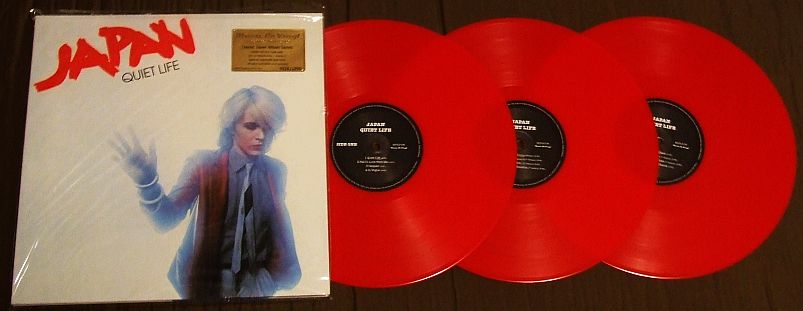
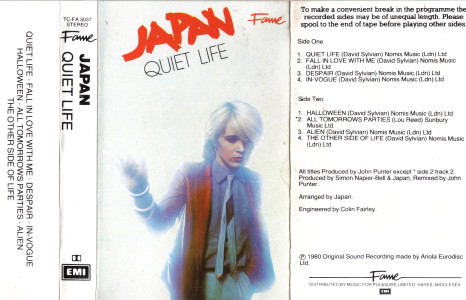
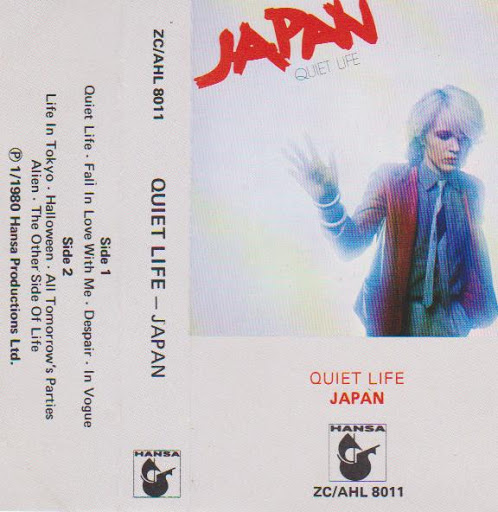




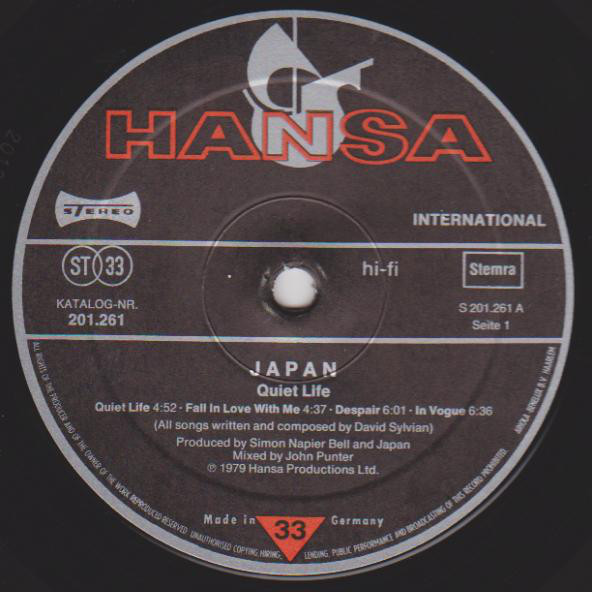




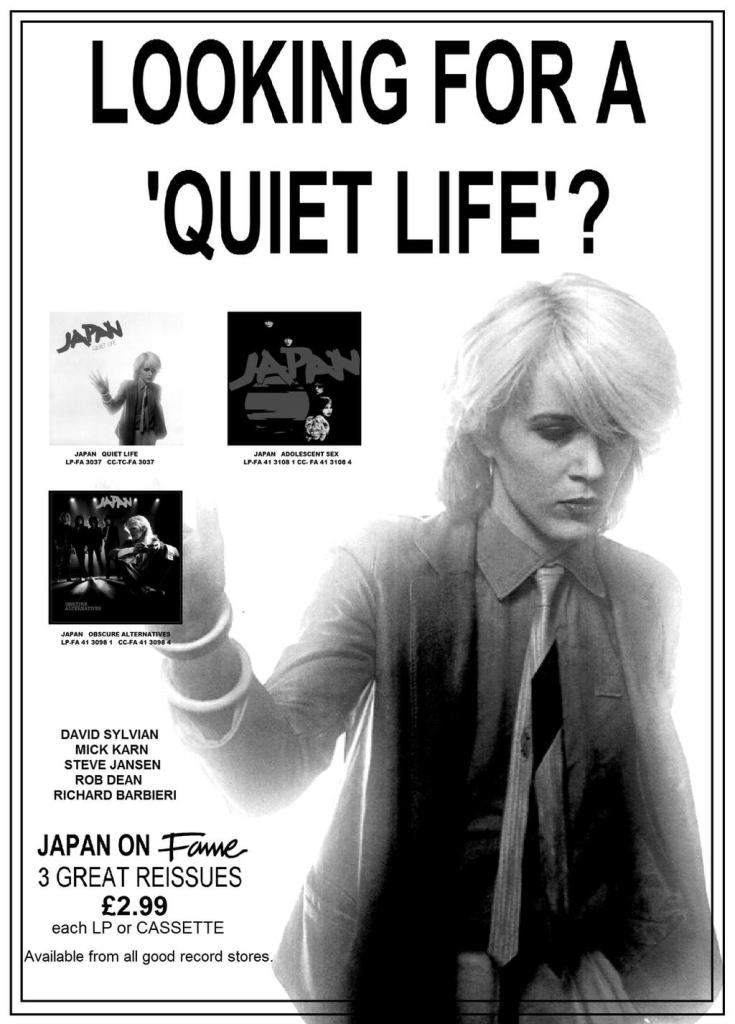





Interesting review. Just out of curiosity what kind of record player do you use?
LikeLike
Technics SL-BD22D with a Denon amp and Sony speakers
LikeLike